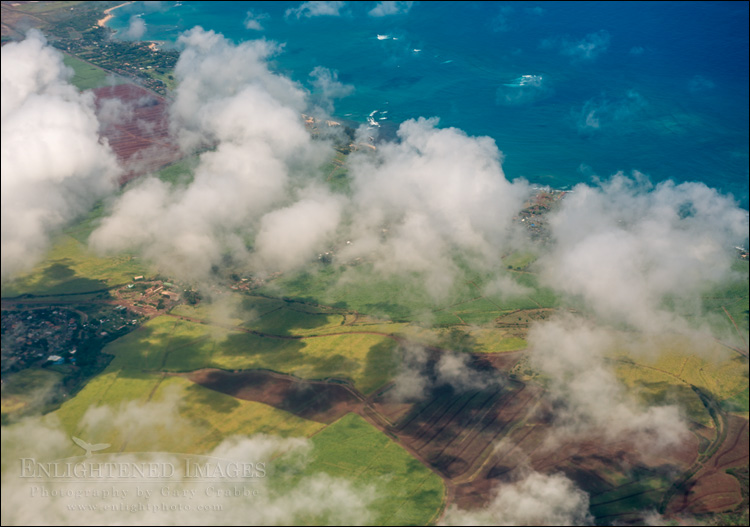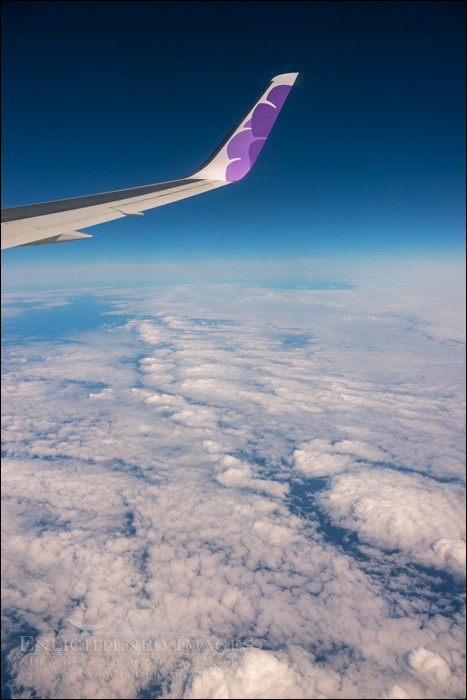Picture: Aerial view of clouds and sugar cane fields over south central Maui while on approach to Kahalui Airport, Maui, Hawaii

I started my last post with the idea that photography, especially travel photography, is often about finding yourself balanced between things you can and can’t control. And such is exactly the case when shooting out of a commercial jet airliner. For those of us photographers who aren’t pilots, any chance to fly becomes a great opportunity to get a perspective on the world that we just don’t get to see on a daily basis.
You can choose your flight, and ideally if you could, you’d choose a window seat in front of the wing, or if not, as far back from the wing as possible. In front of the wing, you won’t have to worry about jet exhaust distorting the air like you’d find sitting behind the wing. (Obviously this is for wing-mounted engine aircraft.) You can also choose the time of day that your flight arrives or departs.
A couple things you can’t control are delays, weather, and the plane’s flight path.
 Picture: Aerial view of clouds over the Pacific Ocean enroute to Hawaii
Picture: Aerial view of clouds over the Pacific Ocean enroute to Hawaii
One other thing you can’t control, from a photographic concern, is the (visibility) quality of the windows. Are they clean, or are they scratched to all heck. Are they scratched on the inside, outside, or both. Depending on these factors, you might be able to get some great shots, or you might be shooting through the proverbial bottom of a Coca-Cola bottle. If the window are scratched, like mine were, one of the best tips for still getting a semi-decent picture is to shoot with a very wide aperture, like f/2.8 if possible, and look for a portion of the window that may not have as many scratches. At higher f-stops, even starting at f/5.6 scratches start becoming more visible, appearing like soft, out of focus blobs, akin to what a spray of water drops on your lens creates.
My other tip is to keep your camera
lens as close as possible to the window, and if you see reflections in the window, see if you can’t twist your body to block the reflections. If you’re traveling with someone, you can ask them to hold up a coat, sweater, or blanket to block the reflection. In a worse case scenario you could throw a jacket or blanket over you’re own head and shoulders while trying to hold it over the window as well, using it like a cloth on a view camera.
A final tip, don’t worry about using a polarizer or split ND filter. At high altitude, the sky is already so dark, you won’t need a split filter. And if you use a polarizer, you’ll immediately notice the view from your specially coated airline window suddenly has a rainbow of colors in it, like someone washed your window with tie-dye inks. Pretty enough for a snapshot, but not for something that would be of publishable or print-worthy quality.
—
![]()
If you like this post , I would greatly appreciate it if you’d consider sharing this with your friends using one of the Social Media sharing buttons located at the top of this post. You can also sign up to receive free updates by email when future posts are made to this blog.
![]()
—
Image ID#: 140814a_HI-0042 (Maui aerial)
Click here for Information & Pricing on larger paper, canvas, or metallic prints, incl. matted & framed prints. For complete purchase options, please contact me directly.
![]()
—
Gary Crabbe is an award-winning commercial and editorial outdoor travel photographer and author based out of the San Francisco Bay Area, California. He has seven published books on California to his credit, including “Photographing California; v1-North”, which won the prestigious 2013 IBPA Benjamin Franklin Gold Medal award as Best Regional title. His client and publication credits include the National Geographic Society, the New York Times, Forbes Magazine, TIME, The North Face, Subaru, L.L. Bean, Victoria’s Secret, Sunset Magazine, The Nature Conservancy, and many more. Gary is also a photography instructor and consultant, offering both public and private photo workshops. He also works occasionally a professional freelance Photo Editor.

Another fun thing to do photography-wise (though no real commercial value) from the window seat of an airliner is to take two photos a 1/2 second to 2 seconds apart (depending on the speed of the jet and its altitude) of the landscape to create 3D anaglyphs (from the two photos) of the land below.
Here’s a link to a quick & dirty anaglyph I created today with my iPhone from two shots I took while flying over the Angeles National Forest just north of Burbank on a Southwest flight from Burbank to San Jose: http://goo.gl/rUWLbp
(To view the anaglyph in 3D you need to wear a red-cyan 3D glasses like this one from Amazon: http://www.amazon.com/Red-blue-Anaglyph-3D-Glasses-game-Extra/dp/B003LWYGPE/ )